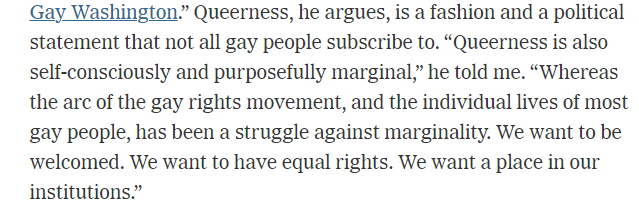The Anti-Queer New York Times
What does it mean, when straight reactionaries take up the cause of gays and lesbians, standing up for their right not to be part of an acronym or an umbrella term. Obviously it's not good for trans people. But, is it even good for gay men and lesbians?
A New York Times opinion columnist is concerned about something. Pamela Paul, a straight woman, has noticed usage of the word “queer” seems to be rising, while use of “gay” and “lesbian” has decreased concurrently. Paul noticed this, perhaps because David Sedaris mentioned it, and she doesn’t like it.
But, why doesn’t Paul like it? I’ve read the essay twice, and I’m still struggling to answer that question clearly but I’ll do my best with it.
It doesn’t seem to be specific to the word queer, because it’s clearly not only the word queer Paul doesn’t like. She also doesn’t like the use of the LGBTQ+ acronym:
The above comes near the beginning of the column. It’s not just an aside, which means it’s not just secondary. We can therefore throw out anything Paul says about the negative connotations of the word queer specifically, for example that it’s got a negative connotation of also meaning weird, while gay has a positive connotation of meaning happy, because they must not have gotten to the heart of the matter, unless they apply to LGBTQ+ equally.
It looks like Paul is concerned that gays and lesbians are feeling crowded out. So… who all is doing the crowding?
According to the above passage, the interlopers seem to be “transgender, gender neutral, nonbinary, agender, pangender, genderqueer, demisexual, asexual, and two spirit.” Paul doesn’t feel these folks should share an acronym with lesbians, gays, and to a lesser extent bisexuals (I get a distinct sense that Paul might be a little wobbly on bisexuals, but when she does remember to mention them she seems to group them with the lesbians and gays she likes, and not the Ts and Qs she doesn’t.)
At face value, Paul seems to be arguing that many lesbians and gays have fought hard for their acceptance and mainstream legitimacy, and it’s unfair to them they’d have to share an acronym or an umbrella term with people whose identities aren’t as acceptable. There’s other stuff there too, there’s an undercurrent of hostility to the idea of gender minorities’ existence, but that’s the one real objection Paul is openly presenting.
At base, this an argument I dislike, but let’s set my personal feelings aside a moment. Let’s set aside, too, my pique, as an adult transgender man of the same generation as the columnist, at being treated as some sort of illegitimate upstart by a straight woman who used to be married to Bret Stevens, and is currently married to a hedge fund manager. No pique, there is no place for you here, because what I find I’m really curious about is another question: Is this attitude of slamming the door shut on we infiltrating transsexuals actually helpful for assimilationist-minded gays and lesbians?
In theory, perhaps it could be. Straight cisgender culture could all decide, tomorrow, that gay men and lesbians (and maaaaaaybe bisexuals) are respectable, normal, upright citizens, while also slamming the door closed forever on all trans people, nonbinary people, asexuals, and anyone else who might consider themselves part of the long tail of the LGBTQ+ acronym.
HOWEVER. The cis hets show no signs I can see of actually wanting to do this. In Florida, gay and lesbian teachers are afraid for their jobs, as merely mentioning their spouses could be considered inappropriate sexual instruction in their classrooms. Across the country, extremists are joining with conservatives and increasingly targeting drag queens, a staple of gay male culture, almost none of whom are actually transgender.
So it seems that no truce has been proposed in this, the umpteenth year of culture war. No compromise has been offered, to trade trans lives for gay ones. To the contrary, the right seems rabidly invested in moving from transphobia back to homophobia as fast as humanly possible. And yet, for some reason, some of the people on the assimilationist side of a very old debate which started in the gay community act as if the only thing causing the right to target them is the existence of their allies with more margialized identities.
It’s nonsense! And, it’s very dangerous nonsense for gay men and lesbians, because it tempts them into fighting their own allies, we humble transes, instead of fighting the people who want to drive them from their jobs, erase their marriages, and brutally attack their drag queens.
Paul is a reactionary. It’s clear she doesn’t really know why she doesn’t like the word queer, she just knows she doesn’t like it. That she’s allowed to write about her poorly thought through distaste in the pages of the New York Times is, primarily, a New York Times problem. A lot of white straight ladies of a certain age find the word queer a bit distasteful. However, there are people who should know better, and those are gay men and lesbians. Because however much they may want to kick us off the acronym (and, remember, lesbians were in that boat once, when gay men resisted having any mere women with them in the struggle for equality), the facts are that the right is gunning for them too. The forces currently arrayed against the LGBTQ+ community have neither asked for, nor offered, any compromises.





